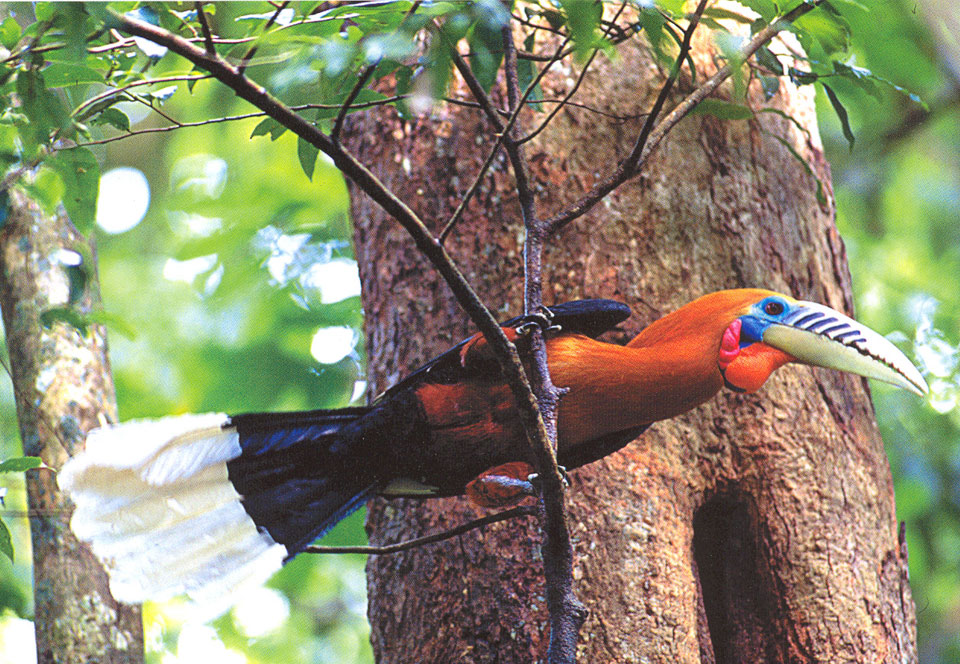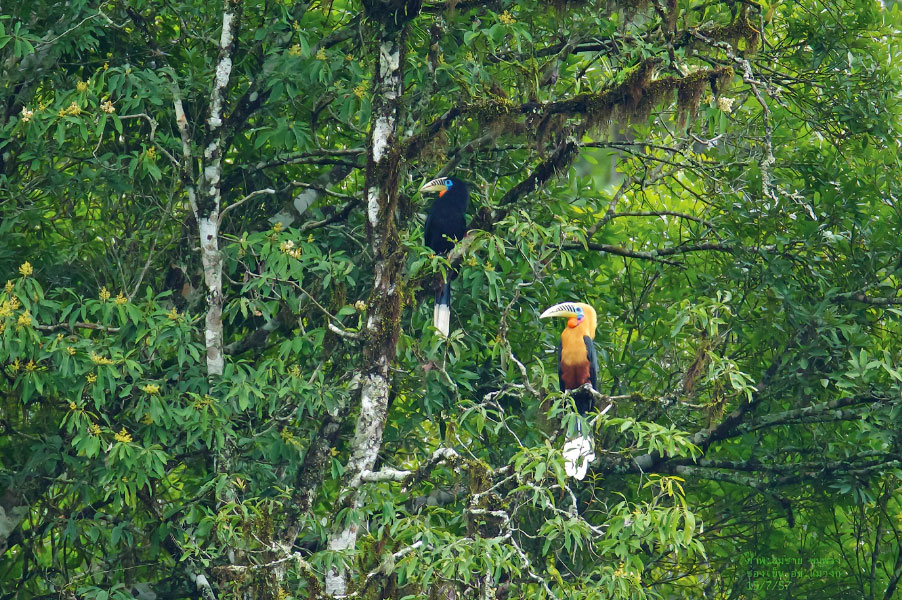Rufous Necked Hornbill (Aceros nipalensis )
Currently once again considered distinct and the only member of its genus, although it was recently joined by some of its closest relatives in a subgenus Rhyticeros within a greater genus Aceros.
Currently once again considered distinct and the only member of its genus, although it was recently joined by some of its closest relatives in a subgenus Rhyticeros within a greater genus Aceros.

Size 92-122 cm. Male 2500 g; female 2270 g. The most colorful large hornbill, with glossy black wings with white trailing edge, mantle and top half of tail black with rest white.
The male has rufous head, neck and underparts, pale ivory bill with black grooves on upper mandible, and turquoise blue orbital skin connected with cobalt blue cheeks and scarlet red pouch with dark blue line. It is distinctive within its range.
The female is all-black but can be distinguished from female Wreathed and Plain-pouched Hornbills where they overlap by blue (not reddish) bare skin around eye, red (not blue) pouch and heavy black stripes on upper mandible of bill, without visible casque, and wings with white trailing edge. Juveniles of both sexes resemble adult male in plumage but paler, and bill smaller without black grooves.
The number of the grooves is somewhat related to the bird’s age. The call is a mellow but powerful cuckoo- or pigeon- like series of descending cooing notes “kup-kup…ku-kup-kup”
Occurs in extensive tracts of primary evergreen and deciduous forests. It is a lower montane species that prefers remote forested ridges and hillsides in the 600-1,800 m elevation range. Has been recorded as low as 150 m and as high as 2,200 m.It frequently forages along watercourses in hill evergreen forest.
In Huai Kha Kheang WS,Thailand, it feeds on fruits of 17 identified species or 74% of total diet dominated by Polyalthia simiarum (Anninaceae), Beilschmiedia gammeiana (Lauracaea),Knema laurina (Myristicaceae) and Aglaia cucullata (Meliaceae); figs constitute only 4 % and animal food 22% of diet.
Among 25 identified animal prey, crab, snakes Acanthosaura cicadas and frogs are dominant. Feeds inside the canopies, commonly comes to the ground, particularly by creeks.It is probably sedentary and territorial; it moves in pairs or in small family groups of 4-5 birds, occasionally more, up to 15 birds. From radio tracking it seems to stay within home range of about 25 km all year round in hill evergreen forest of Huai Kha Kheang WS.
In non-breeding season it travels extensively up to 340 km locally in search of fruiting trees or 3.7 km daily which is not much different from daily travels in the breeding season (3.5km). A family roosts in hill evergreen forest at 900-1,000 m a.s.l. and within 200 m from a watercourse.


Breeds in the first half of the year, courtship display has been observed in mid-April in Bhutan, eggs are laid from Jan-Jun. In Thailand, female seals in Jan-Feb, and 1-2 chicks fledge in May-Jun.The nest is a natural cavity in a large, live forest tree, particularly in Cleistocalyx nervosum (Myrtaceae) (68% of total nest trees), some 10-30 m above the ground in a hill evergreen forest . The female seals herself in using her droppings and food pulp, and lays 1-2 eggs. She stay in the nest for 121 days (range 105-152 days), and emerges with the chicks.
However, exact incubation and fledging periods are not known. At Huai Kha Kheag,Thailand, 22 nesting attempts studied involved 22 pair, with 15 pairs(68%) successfully raising a mean of 1.3 young per nest